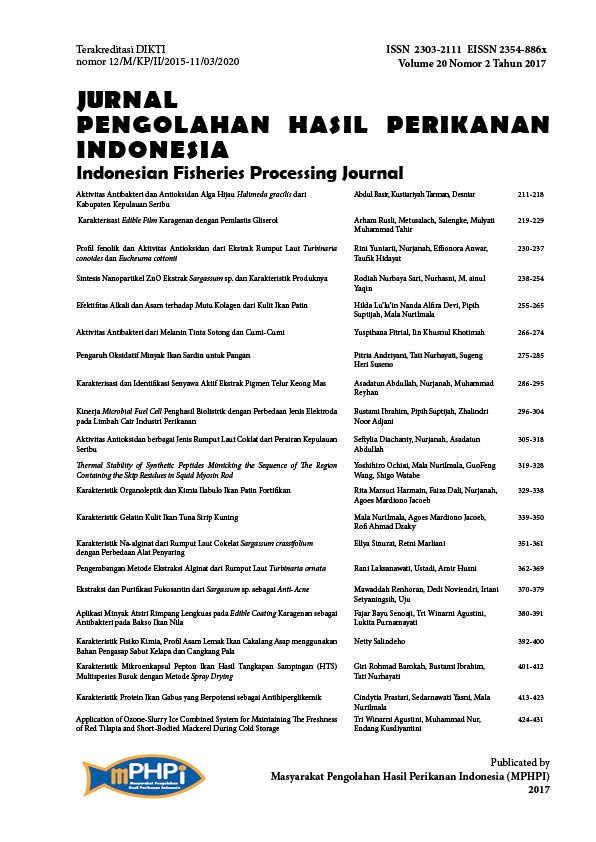The Characteristics of Sodium Alginate from Brown Seaweed Sargassum crassifolium with Different Filtering Tools
Abstract
Indonesia is the largest producer of seaweed in the world, one of the potential marine biological resources is the brown seaweed (Sargassum crassifolium) known as an alginate producer. Alginate extraction through demineralization stage, neutralization, extraction, filtration, precipitation and bleaching. Filtration stage is a very influential process on the quality of alginate produced. In this research, filtering using different tools screen vibrator and hydraulic filter press was conducted to characterize Na-alginate seaweed Sargassum crassifolium using both filter tools. Quality of sodium alginate (yield, viscosity, gel strength, syneresis, whiteness, moisture content, ash, and pH) was determined. The result showed that the viscosity, gel strength, syneresis, and whiteness of alginate obtained using filter press showed the best result. The yield of sodium alginate produced by filter press was 10.91±4.33%, with characteristics of viscosity 82.66±112.46 cP, gel strength 353.54±184.51 g/cm2, syneresis 2.99±0.55%, whiteness 60.53±9.09%, moisture content 13.31±0.77%, ash 26.69±0.82% and pH 6.05±0.57. Based on a parameter of alginate (yield, moisture content, ash, and pH) showed that vibrator method produced alginate with better characteristics. The sodium alginate produced has average yield 19.22±5.68%, viscosity 57.5±21.79 cP, whiteness 29.7±4.45%, gel strength 327.63±55.15 g/cm2, syneresis 4.34±0.78%, moisture content 10.23±1.68%, ash 24.94±4.41% and pH 7.03± 2.60. Operationally the filter press was more effective and efficient in filtering to result from Na-alginate compared to the screen vibrator.
Authors
SinuratE., & MarlianiR. (2017). The Characteristics of Sodium Alginate from Brown Seaweed Sargassum crassifolium with Different Filtering Tools. Jurnal Pengolahan Hasil Perikanan Indonesia, 20(2), 351-361. https://doi.org/10.17844/jphpi.v20i2.18103
Authors who publish with this journal agree to the following terms:
- Authors retain copyright and grant the journal right of first publication with the work simultaneously licensed under a Creative Commons Attribution License that allows others to share the work with an acknowledgement of the work's authorship and initial publication in this journal.
- Authors are able to enter into separate, additional contractual arrangements for the non-exclusive distribution of the journal's published version of the work (e.g., post it to an institutional repository or publish it in a book), with an acknowledgement of its initial publication in this journal.





